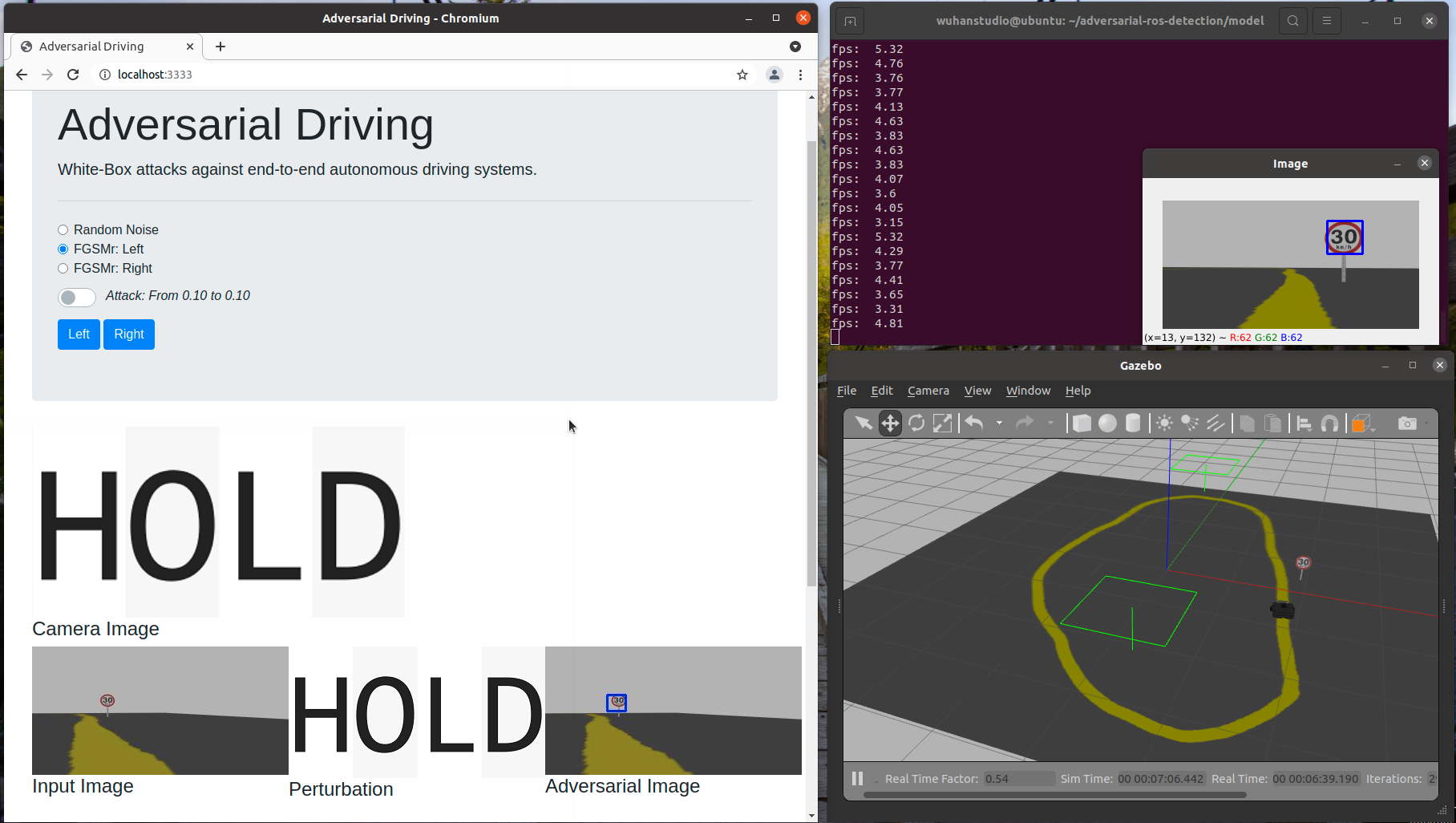Attacking End-to-End Object Detection Systems
$ sudo apt install ros-noetic-desktop
$ sudo apt install ros-noetic-rosbridge-suite ros-noetic-turtlebot3-simulations ros-noetic-turtlebot3-gazebo
$ cd ros_ws
$ rosdep install --from-paths src --ignore-src -r -y
$ catkin_make
$ source devel/setup.sh
$ export TURTLEBOT3_MODEL=waffle
$ roslaunch turtlebot3_lane turtlebot3_lane_traffic_signs.launch
$ roslaunch rosbridge_server rosbridge_websocket.launch
$ cd model
# You may need to put the turtlebot on track first
# rosrun teleop_twist_keyboard teleop_twist_keyboard.py
# For real turtlebot3
$ python3 drive.py --env turtlebot --model yolov4-tiny-traffic.h5
# For Gazebo Simulator
$ python3 drive.py --env gazebo --model yolov4-tiny-traffic.h5
This is just a website, your can use any web server, just serve all the content under client/web.
The client is built as a single executable file.
$ ./client
For Linux and Mac, or other Unix, the server can be built with:
$ go get -u github.com/gobuffalo/packr/packr
$ go get github.com/gobuffalo/packr@v1.30.1
$ packr build
The web page will be available at: http://localhost:3333/
That's it!
The following script collects image data from the topic /camera/rgb/image_raw and corresponding control command in /cmd_vel. The log file is saved in driving_log.csv, and images are saved in IMG/ folder
$ cd model/data
$ # Collect center camera data
$ python3 line_follow.py --camera center --env gazebo
$ python3 ros_collect_data.py --camera center --env gazebo
Once the data is collected, we need to label images before training the model. This tool labelimg is used for labelling.
After labelling, you can use the following script to generate the training and testing set.
$ python3 train_test_split.py
Now we are ready to train the model using the darknet framework:
$ git submodule init
$ git submodule update
$ cd model/utils/darknet
$ # If you have a GPU, you may need to change the Makefile
$ # Compiling the darknet binary
$ make
$ cp -r ../darknet-conf/one-class/* ./
$ ./darknet detector train data/obj.data cfg/yolov3-tiny-traffic.cfg yolov3-tiny.conv.11
Finally, we can convert the darknet *.weights file to keras *.h5 file:
$ cd model/utils/keras-YOLOv3-model-set
$ python3 tools/model_converter/convert.py cfg/yolov3-tiny-traffic.cfg weights/yolov3-tiny-traffic.weights weights/yolov3-tiny-traffic.h5
$ ./darknet detector train data/obj.data cfg/yolov4-tiny-traffic.cfg yolov4-tiny.conv.29
Similarly, we can convert the darknet *.weights file to keras *.h5 file:
$ cd model/utils/keras-YOLOv3-model-set
$ python3 tools/model_converter/convert.py cfg/yolov4-tiny-traffic.cfg weights/yolov4-tiny-traffic.weights weights/yolov4-tiny-traffic.h5
Before training the model, we need to convert the format of annotation files:
From:
class_id x_center y_center width height
0 0.625000 0.346875 0.081250 0.143750
To:
image_file_path x_min,y_min,x_max,y_max,class_id
path/to/img2.jpg 120,300,250,600,2
This can be done using the following script that generates a trainval.txt file:
$ cd model/utils/keras-YOLOv3-model-set/
$ cp -r ../../data/IMG ../../data/*.txt ./
$ cp ../keras-conf/* ./
$ python3 darknet_to_keras_trainval.py
Finally, we can train the model:
$ python3 train.py --model_image_size=160x320 --model_type=yolo4_mobilenet_lite --anchors_path=configs/yolo4_anchors.txt --annotation_file=trainval.txt --classes_path=obj.names --eval_online --save_eval_checkpoint
Save the model as keras:
python3 yolo.py --model_type=yolo4_mobilenet_lite --weights_path=logs/000/trained_final.h5 --anchors_path=configs/yolo4_anchors.txt --classes_path=obj.names --model_image_size=160x320 --dump_model --output_model_file=yolov4_mobilenet_lite.h5
Test the model:
python3 yolo.py --model_type=yolo4_mobilenet_lite --weights_path=yolov4_mobilenet_lite.h5 --anchors_path=configs/yolo4_anchors.txt --classes_path=obj.names --model_image_size=160x320 --image
